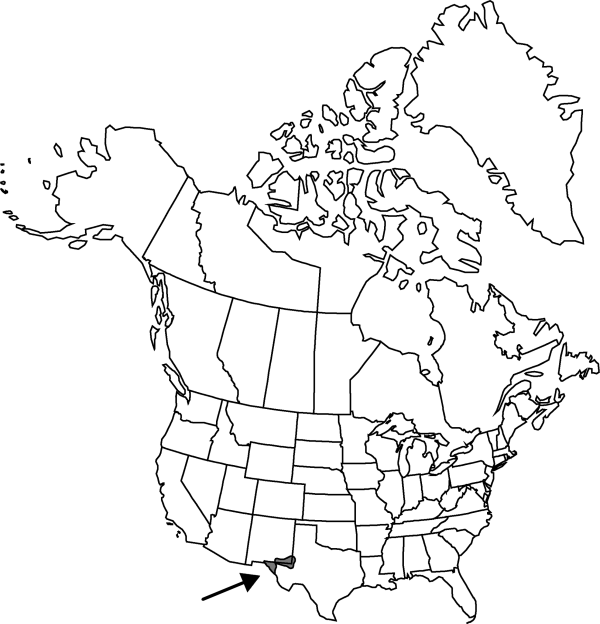Difference between revisions of "Opuntia polyacantha var. arenaria"
Cact. Succ. J. (Los Angeles) 70: 188. 1998.
Common names: Sand pricklypear
Basionym: Opuntia arenaria Engelmann
Treatment appears in FNA Volume 4. Treatment on page 147.
FNA>Volume Importer |
FNA>Volume Importer |
||
| Line 20: | Line 20: | ||
}}<!-- | }}<!-- | ||
| − | --><span class="statement" id="st- | + | --><span class="statement" id="st-undefined" data-properties=""><b>Stem </b>segments narrowly obovate, 4–7 × 2–3(–5) cm; areoles 4–6 per diagonal row across midstem segment, 8–11 mm apart. <b>Spines</b> in most areoles, of 2 kinds: major spines 1–3 per areole, only in distal 3–9 areoles, reflexed to porrect, brown, longest 20–40 mm; minor spines 5–7 per areole, strongly deflexed, white, 4–7 mm, except middle one to 14 mm. <b>Fruits</b> slender; areoles 10–14, bearing 3–6 spines, to 8 mm. <b>2n</b> = 22.</span><!-- |
-->{{Treatment/Body | -->{{Treatment/Body | ||
| + | |phenology=Flowering late spring. | ||
|habitat=Sandy barren areas, small dunes | |habitat=Sandy barren areas, small dunes | ||
|elevation=1000-1300 m | |elevation=1000-1300 m | ||
| Line 42: | Line 43: | ||
|basionyms=Opuntia arenaria | |basionyms=Opuntia arenaria | ||
|family=Cactaceae | |family=Cactaceae | ||
| + | |phenology=Flowering late spring. | ||
|habitat=Sandy barren areas, small dunes | |habitat=Sandy barren areas, small dunes | ||
|elevation=1000-1300 m | |elevation=1000-1300 m | ||
| Line 49: | Line 51: | ||
|publication year=1998 | |publication year=1998 | ||
|special status= | |special status= | ||
| − | |source xml=https://jpend@bitbucket.org/aafc-mbb/fna- | + | |source xml=https://jpend@bitbucket.org/aafc-mbb/fna-data-curation.git/src/9216fc802291cd3df363fd52122300479582ede7/coarse_grained_fna_xml/V4/V4_285.xml |
|subfamily=Cactaceae subfam. Opuntioideae | |subfamily=Cactaceae subfam. Opuntioideae | ||
|genus=Opuntia | |genus=Opuntia | ||
|species=Opuntia polyacantha | |species=Opuntia polyacantha | ||
|variety=Opuntia polyacantha var. arenaria | |variety=Opuntia polyacantha var. arenaria | ||
| − | |||
| − | |||
| − | |||
| − | |||
| − | |||
| − | |||
| − | |||
| − | |||
| − | |||
| − | |||
| − | |||
| − | |||
| − | |||
| − | |||
| − | |||
| − | |||
| − | |||
| − | |||
| − | |||
| − | |||
| − | |||
| − | |||
}}<!-- | }}<!-- | ||
-->[[Category:Treatment]][[Category:Opuntia polyacantha]] | -->[[Category:Treatment]][[Category:Opuntia polyacantha]] | ||
Revision as of 14:03, 27 July 2019
Stem segments narrowly obovate, 4–7 × 2–3(–5) cm; areoles 4–6 per diagonal row across midstem segment, 8–11 mm apart. Spines in most areoles, of 2 kinds: major spines 1–3 per areole, only in distal 3–9 areoles, reflexed to porrect, brown, longest 20–40 mm; minor spines 5–7 per areole, strongly deflexed, white, 4–7 mm, except middle one to 14 mm. Fruits slender; areoles 10–14, bearing 3–6 spines, to 8 mm. 2n = 22.
Phenology: Flowering late spring.
Habitat: Sandy barren areas, small dunes
Elevation: 1000-1300 m
Distribution

N.Mex., Tex., Mexico (Chihuahua).
Discussion
Of conservation concern.
Selected References
None.
Lower Taxa
None.